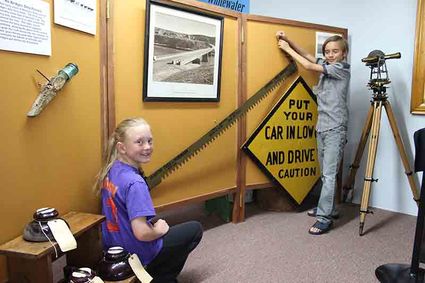Spring is class field trip season, for more than just a road trip
June 15, 2016

Steve Edwards
Mya Beireth, kneeling, and Listat Gonzalez, standing to the right of the photo, check out the crosscut saw used by state Senator Fred Robinson and Montana Governor J. Hugo Aronson. In 1959 the saw was used to cut a cottonwood log in two during the dedication of the Robinson bridge across the Missouri River. The sawing was akin to a 'ribbon cutting' to open the new bridge.
The spring field trip season is done for this year. It's that time of the year that you see a lot of school buses parked in front of regional museums and historic sites. Along the Hi-Line the kids were taking to the highways and byways for their annual field trips.
Students and teachers seem to relish a few hours away from the classroom and a chance to learn in a new environment. Museum directors and volunteers look forward to the visits as it gives them a chance to showcase their facilities and briefly capture the minds of kids who are of a generation that gets their information electronically from a variety of gadgets and, often, have very little knowledge of how their forebears lived. Museums show kids the real deal of what the 'good old days' looked like.
The fourth graders from Meadowlark Elementary in Chinook made their spring field trip to Malta for a visit to two museums, a tour of an historic house and a soak at the Sleeping Buffalo Hot Springs. I was at the Phillips County Museum gathering some information for another story and saw the students several times as we would pass near exhibits. I ran in to a group of Meadowlark students at the Great Plains Dinosaur Museum which is just across the parking lot from the county museum.
I didn't get to talk to the students but did talk to some of the officials with the museums. I was curious about what fourth graders really liked and the volunteers and staffers at the museums shared some information.
Lori Taylor, Curator at the Phillips County Museum, led several of the small groups of Chinook students through parts of the county museum. The museum is full of displays about local history, some of the famous outlaw gangs that hung out in the area and some prehistoric exhibits of dinosaurs.
Taylor said, "Fourth graders are at the age where they can relate historical artifacts to their own family. It's not uncommon for a fourth grader, looking at an exhibit of pioneer tools or household items to say, "My grandma has one of those, she let me use it one time to see how it works." And fourth graders like to ask questions, they still feel it's okay to ask if you don't know something."
"The kids from Chinook," Taylor added, "are well prepared for their visit to the museum. The teachers must spend time talking about what they will see and things to look for. That helps the kids to observe and learn as they look at the exhibits and displays." According to Taylor, many schools bring the same grade level students to the museum for several years in a row, then find a new destination for a while. She said she tends to see the same teachers, with different students, for several years.
Over at the Great Plains Dinosaur Museum, which specializes in dinosaur-related exhibits, Cary Woodruff, the Director of Paleontology for the museum, was sharing information about dinosaurs. Dolly Ann Willutt, the Scientific Liaison for the museum, had observed the students and told, "They seemed very interested in "Julie" the raptor. Typically, we think of raptors as a type of bird, but Julie never flew."
Willutt explained, "Julie had feathers but she used them for running fast and being agile to catch game. Julie was a carnivore so she was a meat-hunter. The Chinook kids seemed really fascinated by an animal with feathers that didn't fly."
"Another tidbit that seemed to catch the fourth graders' attention," per Willutt, "was how to detect if a bone is really a fossil. She said the paleontologist showed them that by putting a bone fragment to the tongue, and holding it there, one can tell if a fossil is real. If the fragment tastes sticky, it's likely a genuine fossil." Note to parents of fourth graders: If you see your kids picking up ancient looking fragments and holding them to their tongues, there is a reasonable explanation.
Willutt, herself a retired teacher and school administrator, shared one other factoid about kids and fossils. She said, "It's a fact that kids tend to find random fossils more readily than adults." She shared several stories of very young children finding fossils and bringing them for identification by the museum staff. Asked why kids might be more adept at finding fossils, she opined, "I think they don't get their minds all full of issues like adults-they don't worry about what to fix for supper or if the checkbook will balance. They just focus on finding fossils and shut out the rest of the world." Second note to parents: If your significant other seems to be spending a lot of time looking down for bones, best check there is food in the pantry and the checkbook is not overdrawn-they could be in 'fossil finding mode."


